
On June 4, 2020, a LIFE Climate CAKE PL webinar was held to demonstrate the possibilities of using the EPICA agriculture sector model to analyze the effects of climate policy in this sector. Presenting the results of the analysis carried out by CAKE experts was an opportunity to discuss and share suggestions from the participants of the meeting regarding research topics and areas that subsequent analyzes would cover.
At the beginning the assumptions and analytical capabilities of the EPICA agriculture sector model were presented – i.e. model scope, analytical scenarios, preliminary modeling results and subsequent planned tasks (including model development). The agriculture sector model – EPICA (Evaluation of Policy Impacts – Climate and Agriculture), carried out as part of the LIFE Climate CAKE PL project, aims to examine the scale of changes in the agriculture sector resulting from the implementation of climate policy instruments. The model covers Poland and analyzes 17 plant and 6 animal activities.
As a results of the analysis, the possibilities of the EPICA model were presented: determining the effects of reducing GHG emissions in the agricultural sector (e.g. impact on the value of commodity production, farmers’ income, prices of agricultural products) or showing the effects (impact on emissions) of introducing some fiscal instruments (e.g. introduction of emission charges) and changes in the approach to the production method (e.g. greater intensification).
The presentation was followed by a discussion in which it was proposed that the model should also include the latest European Commission Farm to fork strategy, which could help state administration make the most optimal decisions in this aspect.
At the end of the meeting, it was announced that the first analysis of the agriculture sector based on the EPICA model, will be published soon on the LIFE Climate CAKE PL website, where results and conclusions will be presented more broadly.
The presentation from the webinar is available below:
 CAKE_Model_EPICA_CAKE_webinar_4_06_2020.pdf (1.8 MiB, 715 hits)
CAKE_Model_EPICA_CAKE_webinar_4_06_2020.pdf (1.8 MiB, 715 hits)

We are pleased to present you three model documentations regarding models: d-PLACE, Energy (MEESA) ,transport (TR3E) and agriculture (EPICA). Preparation of model documentation is part of one of the most important goals of the project: building a comprehensive and consistent analytical toolkit for assessing the measures proposed at the levels of Member States and the EU, including their sectoral dimension.
d-PLACE model is based on the static CGE model called PLACE, which was created in 2013-2016 by members of the Climate Policy Analysis Center (Polish acronym – CAK) cooperating with the Ministry of Economy, the Ministry of the Environment and the Ministry of Finance of the Republic of Poland and experts of the World Bank in cooperation with IOŚ – PIB. d-PLACE model is a recursive dynamic model worldwide and multisectoral. In addition, the big advantage of the model, unheard of in other analyzes of this type, is a very detailed reflection of the EU ETS system and emission limits in individual EU countries under non-ETS.
 CAKE_d-PLACE_model_documentation-1.pdf (1.4 MiB, 4,749 hits)
CAKE_d-PLACE_model_documentation-1.pdf (1.4 MiB, 4,749 hits)
MEESA Energy model (Model for European Energy System Analysis) is a linear model optimizing the coverage of electricity and district heating demand in EU28 specializing in balancing emissions. The analytical tool was designed to thoroughly analyze the role of existing and future energy technologies in achieving the goals set by the energy sector in EU climate and energy policy. The model, covering 28 EU countries as well as Switzerland and Norway, minimizes the total discounted costs of covering the demand for electricity and network heat in the entire analysis period covering 2015-2055 period. For this, MEESA uses over 50 technologies that it can use in each of the 18 load zones considered for each year of analysis.
 CAKE_MEESA_energy-model_documentation.pdf (1.5 MiB, 2,395 hits)
CAKE_MEESA_energy-model_documentation.pdf (1.5 MiB, 2,395 hits)
TR3E transport model (Transport European Economic Model) is based on the concept of partial equilibrium. TR3E model consist of two main modules: passenger and freight. It covers four main areas of transportation: road, rail, aviation and inland and coastal shipping of goods in each of the European Union 28 Member States. TR3E model is based on several data sources. The main data set comes from JRC IDEES database. The IDEES database supplies the model with data on the structure of the fleet, historical activity levels, the level of scrapping, etc. The second main source of data is the TRACCS database (prepared on behalf of the European Commission by Emisia), where information on the costs of transport activity in individual EU Member States comes from.
 CAKE_TR3E_documentation.pdf (2.2 MiB, 1,904 hits)
CAKE_TR3E_documentation.pdf (2.2 MiB, 1,904 hits)
EPICA agricultural model (The Evaluation of Policy Impacts – Climate and Agriculture Model)
The main task of the model is to analyse the impacts of climate and energy policy on agriculture. The EPICA model consists of two integrated modules – market module and farm module – combining a partial equilibrium approach with linear farm activity optimisation programming. This enables the simulation of a proper supply-demand balance of goods produced in the agricultural sector, as well as provides a detailed disaggregation of analysed farm activities. The construction of the EPICA model supports interaction with other CAKE analytical tools, including in particular the d-PLACE model and the MEESA model.
 CAKE_EPICA_model_documentation_.pdf (1.7 MiB, 1,679 hits)
CAKE_EPICA_model_documentation_.pdf (1.7 MiB, 1,679 hits)

On May 12, 2020 r. a webinar took place on “European Green Deal 2050 – challenges of transformation” organized by IOŚ-PIB/KOBiZE as a part of LIFE Climate CAKE PL project in partnership with the Permanent Representation of the Republic of Poland to the EU. In a 1.5 hour meeting around 200 participants took part.
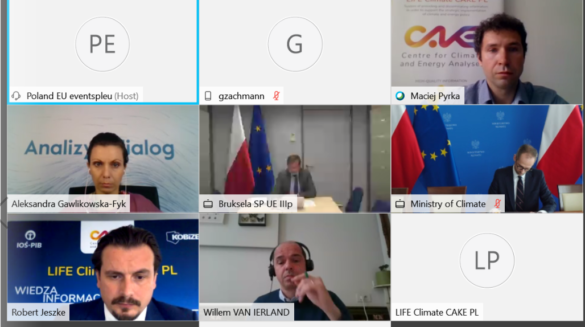 The purpose of the organized webinar was to exchange views on the challenges associated with the transformation towards climate neutrality and the impact of the COVID-19 pandemic on the implementation of the European Union’s ambitious climate and energy policy. Among the distinguished guests at our webinar were Andrzej Sadoś, The Permanent Representative of the Republic of Poland to the EU and Adam Guibourge-Czetwertyński, Undersecretary of State in the Ministry of Climate. The meeting was also attended by Tom van Ierland from DG CLIMA from the European Commission and Georg Zachmann representative of the Bruegel think tank, Robert Jeszke, KOBiZE, Coordinator of the LIFE Climate CAKE PL and Maciej Pyrka, KOBiZE, LIFE Climate CAKE PL CGE model expert .
The purpose of the organized webinar was to exchange views on the challenges associated with the transformation towards climate neutrality and the impact of the COVID-19 pandemic on the implementation of the European Union’s ambitious climate and energy policy. Among the distinguished guests at our webinar were Andrzej Sadoś, The Permanent Representative of the Republic of Poland to the EU and Adam Guibourge-Czetwertyński, Undersecretary of State in the Ministry of Climate. The meeting was also attended by Tom van Ierland from DG CLIMA from the European Commission and Georg Zachmann representative of the Bruegel think tank, Robert Jeszke, KOBiZE, Coordinator of the LIFE Climate CAKE PL and Maciej Pyrka, KOBiZE, LIFE Climate CAKE PL CGE model expert .
The Permanent Representative of the Republic of Poland to the EU, Mr. Andrzej Sadoś emphasized in his opening remarks that the challenges facing Poland and the European Union are unprecedented. They will require not only significant investments, but also far-reaching actions with serious consequences on behalf of a wide range of sectors. The Ambassador referred to the current economic and social situation caused by the COVID-19 crisis while stressing that the scale of the challenges means that the challenge of transformation will be even more difficult than anticipated. Already before the pandemic, the costs of transformation were particularly high for countries such as Poland, and due to the pandemic they are expected to increase even further. Regardless of the level of socio-economic development or the structure of the energy mix, all Member States are faced with new challenges. Strengthening cooperation and building universal tools to stimulate post-crisis reconstruction has a chance to help solve some of the problems.
The Undersecretary of State in the Ministry of Climate, Mr. Adam Guibourge-Czetwertyński, underlined the need for an ambitious and solid recovery plan ensuring the sustainable and equitable development of our continent without burdening the poorest and most vulnerable citizens and regions, and that transformation should lead to a stronger, greener, crisis-proof and united EU.
Mr. Tom van Ierland, DG CLIMA – European Commission, made it clear that raising targets by 2030 despite the current crisis caused by COVID-19 is still a priority for the EC, and the publication of the results of the impact assessment is planned for September this year. The EC representative emphasized that it will be a comprehensive analysis that will assess the possibility of extending the ETS system to the transport and construction sectors. It will also analyze the potential of all EU sectors and policies identified within the European Green Deal (e.g. industrial policy, circular economy, biodiversity, farm to fork) to achieve its goals. The analysis will also cover the role of forests and land use in absorbing emissions. The comprehensive assessment will also consider the impact of COVID-19 and take into account the social aspect, including effects on labour market and employment.
Mr. Georg Zachmann, representative of the Bruegel, drew the attention to the mechanism for adjusting prices at the borders taking into account CO2 emissions, the Energy Tax Directive or the manner of getting revenues to budgets from the auction of emission allowances.
Mr. Maciej Pyrka, KOBiZE, LIFE Climate CAKE PL CGE model expert, presented the results of the analyzes carried out in as part of the LIFE Climate CAKE PL project. In his findings he stressed that implementation of the new greenhouse gas emission reduction targets proposed in the European Green Deal and Climate Law will result in a reduction in the supply of emission allowances in the EU ETS and also trigger a sharpening of current national reduction policies in the non-ETS sectors. The results of the analyzes carried out in as part of the LIFE Climate CAKE PL project suggest that the proposed increase in the reduction target for 2030 may result in a sig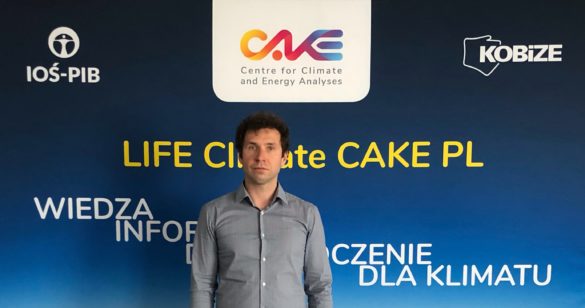 nificant increase in prices in the EU ETS in an extreme case up to 76 EUR / ton in 2030. The high price of allowances can generate high costs for industry and lead to carbon leakage (i.e. relocation of production and investment outside the EU). On the other hand, the proposed emission reduction path by 2050 will mean the necessity to reduce practically to zero emissions from the power generation sector and from some industrial sectors in the Member States. The high price of allowances can generate high costs for industry and lead to carbon leakage (i.e. relocation of production and investment outside the EU). On the other hand, the proposed emission reduction path by 2050 will mean the necessity to reduce practically to zero emissions from the power generation sector and from some industrial sectors in the Member States. Referring to the current situation related to the crisis caused by COVID-19, it is necessary to take into account its effects in assessing the impact of the newly proposed regulations and strategies on Member States, which is difficult because we do not yet have full information about the state of the economy after the crisis.
nificant increase in prices in the EU ETS in an extreme case up to 76 EUR / ton in 2030. The high price of allowances can generate high costs for industry and lead to carbon leakage (i.e. relocation of production and investment outside the EU). On the other hand, the proposed emission reduction path by 2050 will mean the necessity to reduce practically to zero emissions from the power generation sector and from some industrial sectors in the Member States. The high price of allowances can generate high costs for industry and lead to carbon leakage (i.e. relocation of production and investment outside the EU). On the other hand, the proposed emission reduction path by 2050 will mean the necessity to reduce practically to zero emissions from the power generation sector and from some industrial sectors in the Member States. Referring to the current situation related to the crisis caused by COVID-19, it is necessary to take into account its effects in assessing the impact of the newly proposed regulations and strategies on Member States, which is difficult because we do not yet have full information about the state of the economy after the crisis.
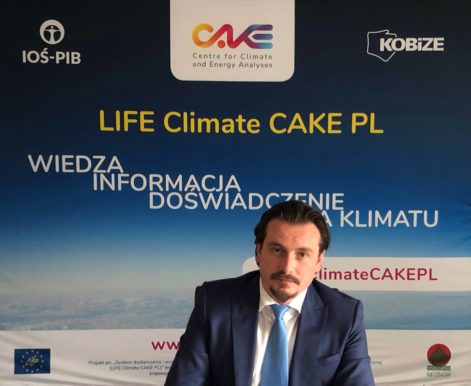 Mr. Robert Jeszke, KOBiZE, Coordinator LIFE Climate CAKE PL project underlined that challenges will also be faced by most sectors of classified as non-ETS. First of all, there will be significant changes affecting secors such as: transport, building and agricultural. In his speech he emphasized that in terms of distribution of emission reductions, we should treat EU ETS sectors and non-ETS sectors in such a way that it would not lead to internal carbon leakage, i.e. leakeage from the EU ETS to the non-ETS area, where such an an example can be seen where high prices of EUA allowances cause some heat consumers to disconnect from heating networks and start to use more individual emission sources (e.g. coal boilers). In addition he highlighted the growing emissions in the transport sector and stressed the need to take this problem into account in assessing the impact of the new climate policy for 2030.
Mr. Robert Jeszke, KOBiZE, Coordinator LIFE Climate CAKE PL project underlined that challenges will also be faced by most sectors of classified as non-ETS. First of all, there will be significant changes affecting secors such as: transport, building and agricultural. In his speech he emphasized that in terms of distribution of emission reductions, we should treat EU ETS sectors and non-ETS sectors in such a way that it would not lead to internal carbon leakage, i.e. leakeage from the EU ETS to the non-ETS area, where such an an example can be seen where high prices of EUA allowances cause some heat consumers to disconnect from heating networks and start to use more individual emission sources (e.g. coal boilers). In addition he highlighted the growing emissions in the transport sector and stressed the need to take this problem into account in assessing the impact of the new climate policy for 2030.
The webinar was moderated by Mrs. Aleksandra Gawlikowska-Fyk, responsible for the Power Engineering project within the Energy Forum.
Presenatation:
 CAKE_webinar_European_Green_Deal_12-05-2020.pdf (1.3 MiB, 911 hits)
CAKE_webinar_European_Green_Deal_12-05-2020.pdf (1.3 MiB, 911 hits)
More information on the website: https://www.gov.pl/web/eu/european-green-deal-2050—challenges-of-transformation—webinar
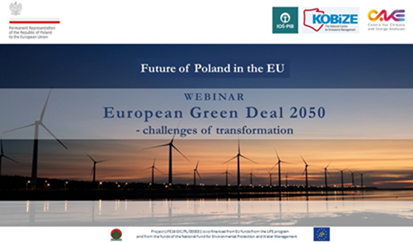

We would like to invite you to the LIFE Climate CAKE PL & Permanent Representation of Poland to the EU webinar on European Green Deal 2050 – Challenges of transformation, which will take place on May 12, 2020 (Tuesday) at 11.00-12.30.
At the meeting, we plan to present to an EU audience the results of analyses obtained under the LIFE Climate CAKE PL project, in particular in the context of the 2050 energy mix and new analyses on impact on emission reduction targets.
Registration untill 12h00 on the 11th May 2020:
PASSWORD: CLIMATE
* link to the webinar will be sent to the registered attendees a day before the event

We are pleased to present the results of our new analysis prepared as part of the LIFE Climate CAKE PL project entitled “The European Green Deal impact on the GHG’s emission reduction target for 2030 and on the EUA prices. Summary” The full version of the publication is in Polish and the summary is in English.
 CAKE_Zmiana-celów-redukcyjnych-i-cen-uprawnień-do-emisji-wynikająca-z-komunikatu-Europejski-Zielony-Ład.pdf (1.3 MiB, 3,141 hits)
CAKE_Zmiana-celów-redukcyjnych-i-cen-uprawnień-do-emisji-wynikająca-z-komunikatu-Europejski-Zielony-Ład.pdf (1.3 MiB, 3,141 hits)
 CAKE_The-European-Green-Deal-impact-on-the-reduction-target-for-2030-and-on-the-EUA-prices.-Summary.pdf (1.0 MiB, 2,423 hits)
CAKE_The-European-Green-Deal-impact-on-the-reduction-target-for-2030-and-on-the-EUA-prices.-Summary.pdf (1.0 MiB, 2,423 hits)
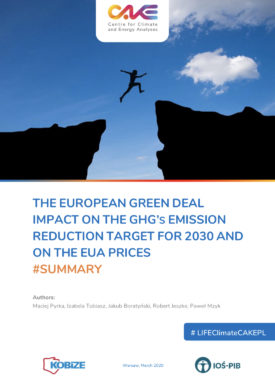 The above analysis is of particular importance in the context of the need to achieve the 2050 climate neutrality objective and the challenges of a just transition.
The above analysis is of particular importance in the context of the need to achieve the 2050 climate neutrality objective and the challenges of a just transition.
The EC’s proposals to tighten climate and energy policy under the European Green Deal and the new European Climate Law project announced today will have a great impact on the European industry and energy sectors, which will bear the very high costs of this transformation. This will particularly affect Poland, whose energy is based on fossil fuels.
In this report has been analysed how increasing the reduction target to 50% and 55% from the current 40% in 2030 may change the reduction of emissions. This concerned sectors covered by the EU emissions trading system (EU ETS) and sectors that are outside this system, i.e. in the non-ETS. It was also examined how new reduction targets for 2030 affect the price of EUA (European Union Allowances).
Below are the most important conclusions from the analysis:
EU ETS
Non-ETS